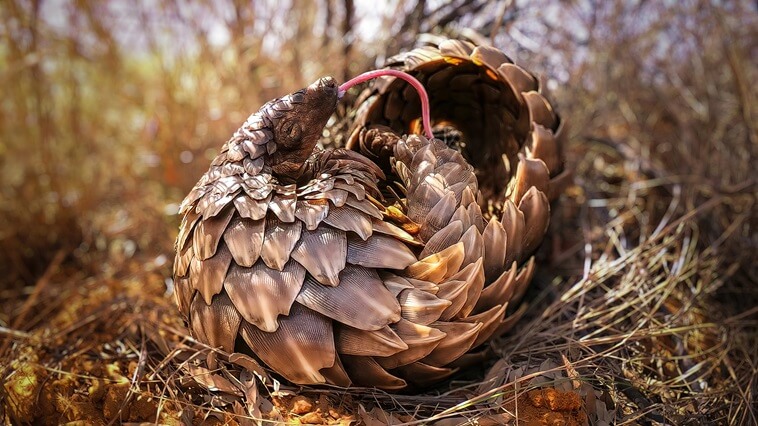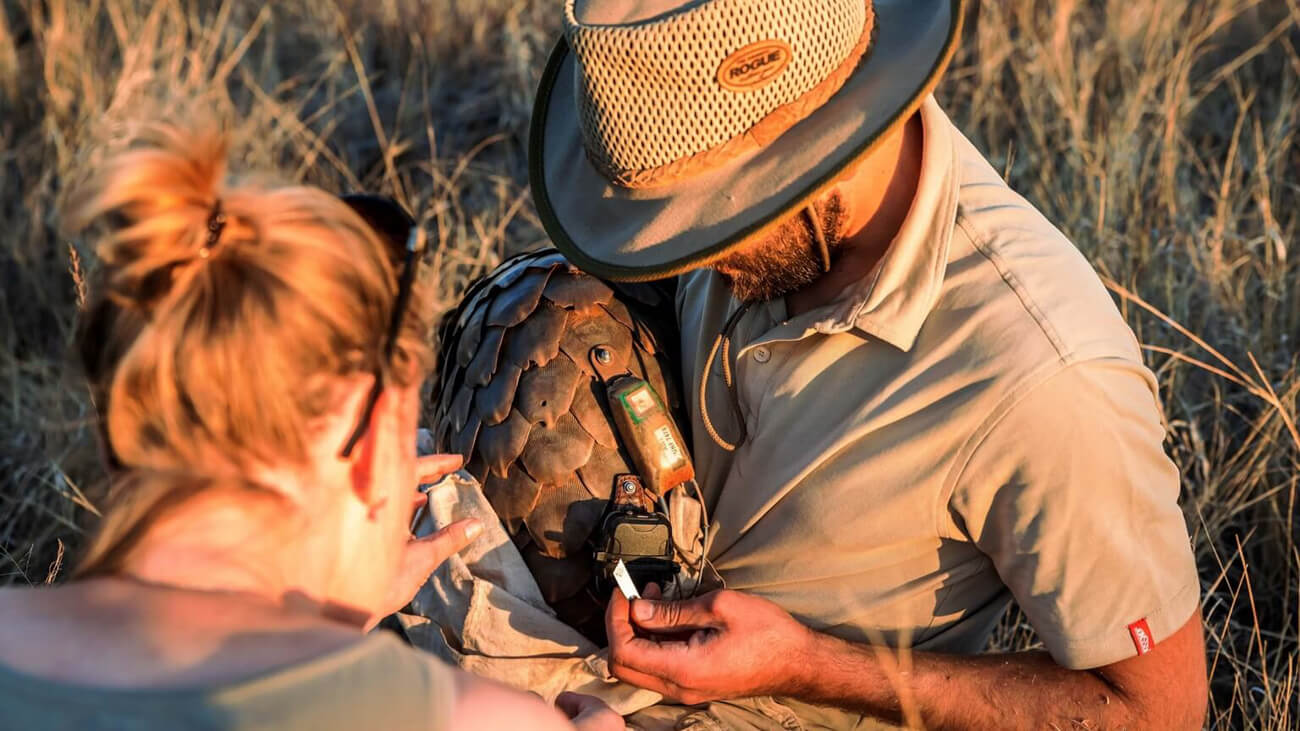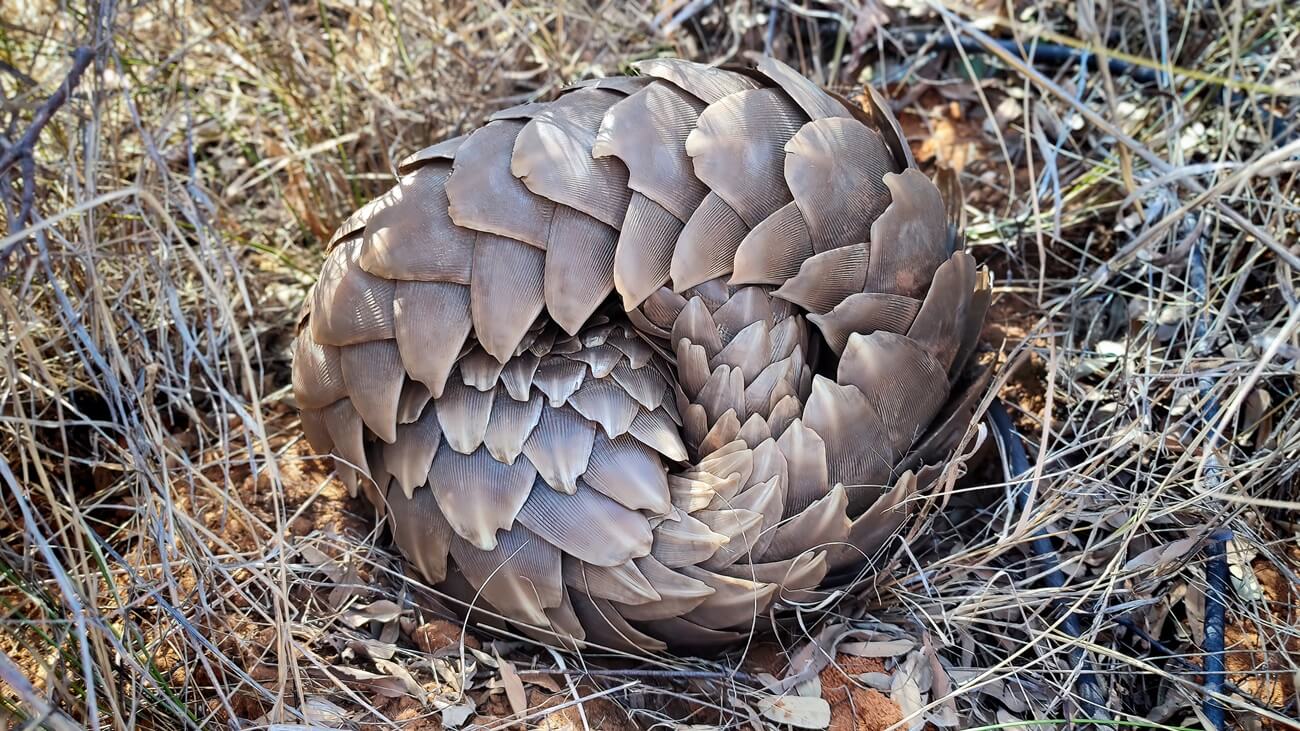Pangolin Safari for Conservation in the Kalahari: Join Our Monitoring Efforts
Pangolin Safari and Monitoring in the Kalahari: Unlocking Secrets to Save the Scaly Anteater
Ground Pangolins (Smutsia temminckii), with their armor-like scales and shy nature, are among the world’s most unique – and most trafficked – mammals. We are committed to understanding their lives in the harsh Eastern Kalahari Bushveld through an effective pangolin safari to monitor individuals as this is crucial for their survival in this habitat. Join our monitoring efforts at Working with Wildlife and become part of the global fight to protect these extraordinary creatures. We want to empower our guests to take part in pangolin conservation action through this pangolin safari initiative.

Meet the Pangolin: Evolution’s Armored Enigma
• Naming and Taxonomy: Pangolins get their name from the Malay word ‘penggulung,’ meaning “one who rolls up.” Their scientific name, Manis temminckii, honors Dutch zoologist Coenraad Temminck. They belong to their own order, Pholidota, reflecting their unusual evolutionary path. While there are currently eight known species, our focus is exclusively on the Temminck’s pangolin as it is the only species occurring in the region.
• Appearance: Pangolins are instantly recognizable by their overlapping scales made of keratin (like our fingernails!). They are sharp-edged and interlock to form a suit of armor. They range in size from 12-39 inches (30-100 cm) and weigh between 3.5-60 lbs (1.6-27kg). Pangolins have powerful claws for digging, long sticky tongues for catching insects, and no teeth!
• Armor and Adaptations: When threatened, a pangolin rolls into a tight ball, protected by its scales. These scales provide a remarkable defense and can easily protect them against lions. They can also lash out with their strong tail and razor sharp scales.
• Distribution: Temminck’s pangolins range across much of sub-Saharan Africa. Historically wider, their populations are now fragmented due to habitat loss, fences, and poaching.


Pangolin Behavior and Ecology
• Social Structure: Pangolins are primarily solitary, except for mothers with pups. They primarily communicate through scent, leaving markings from a gland near their anus.
• Unique Digestion: Pangolins are ant and termite specialists! They demolish nests with their strong claws and lap up insects with their long, sticky tongues. Pangolins have a remarkable way of eating. Since they lack teeth, they ingest small stones and sand along with ants and termites. This grit acts like a gizzard, helping grind their food within their muscular stomachs. They are able to metabolize sufficient moisture from ants and termites, but will drink when given the opportunity.
• Nocturnal Specialists: Pangolins are known to sleep in burrows during the day and emerge at night to find food. They have a keen sense of smell to locate their prey. However, some pangolins, in particular younger animals, are known to be very active during the daytime.
• Temperament and Reproduction: Pangolins are shy and harmless. Their main defense is to roll into a ball – making them tragically easy targets for poachers. Females give birth to a single pup (rarely twins), which they carry on their tail until it develops its protective scales. They are nursed for four months but begin eating ants and termites after only one month. Pangolins reach sexual maturity at 2 years when they leave their moms.
The Threats to a Pangolin’s World
• Poaching and Trafficking: Pangolins are the world’s most trafficked mammal. In some areas, pangolins are hunted for their meat, and their scales are used in traditional medicine, although this is less prevalent with Temminck’s pangolins than some Asian and African tree species.
• Habitat Loss: Conversion of land for agriculture and settlements shrinks their habitat. Private land ownership sees properties fragmented with fences erected.
• Road Collisions: Pangolins are sometimes struck by vehicles at night.
• Electric Fences: While essential (and a legal requirement) for containing dangerous wildlife, electric fences pose an unintended threat to pangolins. Tragically, an estimated 500 – 1000 pangolins die from electrocution on such fences per year across South Africa.
• The Fatal Reflex: A pangolin’s instinct to curl defensively when shocked sadly backfires on these fences. They become trapped against the live wire, unable to escape the continuous shock, leading to death. Pangolin electrocution is a national crisis, highlighting the unintended consequences conservation measures can have on smaller, often overlooked species.


Khamab Kalahari: A Safe Haven for Pangolin
• A Safe Refuge: Khamab Kalahari Reserve is currently home to a wild pangolin population of which very little is known. The reserve also stands as an approved release site for pangolins tragically caught in the illegal wildlife trade. These pangolins are given a second chance at a life with expert care, a suitable environment, and a professional anti-poaching team.
• The Ant Advantage: The Eastern Kalahari Bushveld boasts a remarkable diversity of ant species. This is crucial, as pangolins can be notoriously picky eaters, having grown accustomed to specific ant types. So picky are Temminck’s pangolins that they are not able to survive in captivity.
• Khamab’s Solution: This is where Khamab Kalahari’s diversity becomes invaluable. The reserve’s wide range of ant species maximizes the chance of released pangolins finding their preferred food, giving them the best possible chance for survival upon release.
You can read more about Working with Wildlife and Khamab Kalahari Reserve here.
Pangolin Safari and Monitoring: The Power of Conservation
Working with Wildlife Pangolin Monitoring Initiative
Pangolin monitoring is done under the direction of Khamab Kalahari Reserve, and overseen by leading pangolin specialists Francois Meyer (Conservation Ecologist) and Dr Karin Lourens (Veterinarian – Johannesburg Wildlife Veterinary Hospital), and supported by North West Department of Economic Development, Environment, Conservation and Tourism (DEDECT).
We’re committed to contribute back to pangolin conservation through our pangolin safari and Monitoring Initiative. We hope that our monitoring efforts help in the knowledge base for protecting ground pangolins in the Eastern Kalahari Bushveld.
How We Monitor
- Tracking: Pangolins fitted with satellite tags can be monitored in near real time. VHF tags are also fitted to ensure monitored individuals can be found on the ground.
- Camera Traps: These are placed outside known burrows to reveal pangolin activity and help us identify individuals. Sometimes following one pangolin might be your best way to find another as males are often drawn in by females.
Why a Pangolin Safari Matters
- Population Trends: Attempt to determine if pangolin numbers on the reserve are stable, increasing, or declining? No current data is available on pangolin populations in the area.
- Carrying Capacity: It’s important to determine, as best we can, the estimated number of pangolins currently on the reserve, and how many the area can sustain. Pangolins are territorial, and care must be taken to avoid introducing individuals at the expense of others.
- Diet Decoded: An important part of this pangolin safari involves collecting pangolin scat (droppings) for analysis to identify the ant species they consume, and other hormonal and stress factors. By actively monitoring individuals, we can carefully analyze the ant species consumed by pangolins and note the specific vegetation where these ants are found. Pangolin scats are collected and frozen for future analysis.
- A Broader Impact: This data contributes to an ongoing Khamab Kalahari research project on the lasting impact of historical herbicide use on wildlife populations. We’ll investigate whether ant species occurrence differs in areas with and without herbicide history.
- The Ant Connection: By comparing areas with historic herbicide use to untreated areas, we can use this pangolin safari and monitoring to assess if there’s a correlation with the abundance of certain ant species. This may reveal potential impacts on pangolin populations and other species that depend on a healthy and diverse ant community.
- Mitigating Fence Dangers: A pangolin safari for monitoring requires the fitment of a satellite tag and this enables us to predict their movements. When they approach the reserve’s electrified perimeter, we’re able to intervene and temporarily disable the fence, preventing potential electrocution. A satellite (GPS) tag is used for identifying the estimated area, and the animal’s VHF tag is used for precise positioning.
- Prevention Through Understanding: Witnessing how pangolins interact with electrified fences provides invaluable data. This research can hopefully contribute to the development of solutions to safeguard pangolins while maintaining essential safety barriers for other wildlife. Government mandated fencing regulations are implemented for all reserves housing lions and African wild dogs in South Africa.
- Ecological Role: In theory, being myrmecophagous, pangolins help control ant and termite populations, contributing to a balanced ecosystem. However, given the low density of pangolins throughout sub-Saharan Africa, we cannot know with certainty the significance of their impact.
Ready to join us for this pangolin safari to assist with monitoring? Contact us today!
More questions, read our FAQs and our Testimonials.


FAQ: Your Pangolin Safari and Monitoring Questions Answered
Why are pangolins endangered?
The primary threat to pangolins globally is illegal trafficking while in South Africa, electrified fencing poses an arguably even greater danger. Pangolins are the world’s most Poached mammal, sought after for their scales used in traditional medicine and their meat considered a delicacy in certain markets. In addition to the relentless poaching pressure, pangolins also face habitat loss and the tragic threat of electrocution on fences as their reflex is to coil into a defensive ball, unintentionally wrapping themselves around the fencing wire.
How Can I Help Pangolins?
- Support Ethical Conservation: Choose organizations with proven on-the-ground conservation efforts for pangolins (like Khamab Kalahari Reserve!).
- Donate: The Johannesburg Wildlife Veterinary Hospital cares for pangolins in the immediate aftermath of their rescue and rehabilitates them to the point where a release is made possible.
- Spread the Word: Share what you’ve learned on our pangolin safari and the monitoring involved to raise awareness about their plight. Social media can be a powerful tool, especially for an animal that is known by so few people!
- Responsible Tourism: Choose ethical ecotourism providers committed to the protection of pangolins.
Will I see Pangolins at Working with Wildlife?
Not Necessarily! As is the case with each of our activities, and due to the ever-changing nature of wildlife, activities are dynamic and vary depending on the season or unexpected ecological needs. Our focus is on genuine conservation work, so activities are only performed as and when necessary. We WILL NOT participate in pangolin monitoring should there be no need to do so.
Putting this pangolin safari and monitoring project aside, Khamab Kalahari Reserve offers opportunities to potentially observe pangolins and other nocturnal species in their natural habitat. The reserve is home to Aardvark, Aardwolf, Bat-Eared and Cape Foxes, Brown and Spotted Hyenas, Caracals, Genets, Honey Badgers, Leopard, and Porcupines. This pangolin safari and monitoring often includes a night drive, where your chances of encountering these animals are highest. These ethical encounters contribute directly to pangolin conservation efforts on the reserve.
Can I hold a pangolin during my Working with Wildlife experience?
NO. While pangolins are fascinating, we prioritize their well-being. Holding wild animals can cause them unnecessary stress, so we avoid it unless absolutely necessary, such as for medical care or to take it out of harm’s way. This applies to pangolins just as much as it does to tortoises, chameleons, or snakes. Our team handles any essential interactions. However, you’ll still have incredible opportunities to observe and contribute to pangolin conservation through this pangolin safari!

Fun Fact
Did you know pangolins are bipedal and walk on two legs? With their armor-like scales and unique foraging style, Temminck’s ground pangolins really are among the world’s most captivating creatures! Like tiny armored dinosaurs, they balance on their powerful hind legs, using their long tails and sometimes even their forelimbs for counterbalance. Pangolin movement is a surprisingly good indicator of their overall health. A healthy pangolin walks confidently on two legs, tail held high. This demonstrates their strength and agility in navigating their environment. This extraordinary adaptation makes pangolin tracking an unforgettable part of any Kalahari safari.
A healthy pangolin strides confidently on its hind legs, tail held high. But a weak or injured pangolin may resort to dragging its tail. For pangolins released back into the wild after rehabilitation, like those on conservation-focused pangolin safaris, monitoring their movement patterns becomes essential. It helps ensure they regain their strength and thrive in their natural habitat. Want to witness these incredible creatures in action and support their protection? Consider a pangolin safari dedicated to their conservation.

